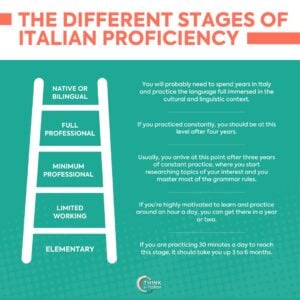What is the gerund in Italian?
To convey a similar meaning to the English progressive tense with -ing (eating, sleeping, studying, etc.) in Italian we use the gerundio (gerund).
Lucia sta mangiando.
Lucia is eating.
Voi state imparando a nuotare.
You are learning to swim.
Sto studiando per l’esame di domani.
I am studying for tomorrow’s exam.
In this lesson, we will learn how and when to use the Italian gerundio semplice, which is mainly translated with the –ing form.
Careful though: there exists a gerund in English too, but its use is not at all the same as the Italian gerundio.
How to form gerundio semplice?
Forming and recognizing the gerundio semplice in Italian is very simple: just add -ando to the stem of -are verbs and -endo to the stem of -ere and -ire verbs:
- -are: mangiare (to eat) becomes mangiando (eating)
- -ere: vedere (to see) becomes vedendo (seeing)
- -ire: dormire (to sleep) becomes dormendo (sleeping)
As always in Italian, there are irregular verbs that form the gerund differently starting from root of their imperfetto tense. For example, for the verbs
Have a look at the table below:
| infinito | imperfetto | gerundio semplice |
| dire (to say) | dicevo | dicendo |
| fare (to do) | facevo | facendo |
| bere (to drink) | bevevo | bevendo |
| tradurre (to translate) | traducevo | traducendo |
When to use gerundio semplice?
This tense in Italian is mainly used in combination with the verb stare, both in the present and imperfect tense to talk about the progression of action as it’s happening or to describe two actions that happen at the same time:
Mario sta cenando.
Mario is having dinner.
Stavamo parlando quando sono arrivati.
We were talking when they arrived.
Cosa state facendo?
What are you doing?
This construction can also be used with the future of stare to refer to actions that will happen at the same time.
Quando ti sveglierai, io starò già lavorando.
When you wake up, I will already be working.
Quando arriveremo, probabilmente starete dormendo.
When we get there, you will probably be sleeping.
If the subject of the two contemporaneous actions is the same, you can use it on its own without the auxiliary stare.
Have a look at the examples below:
Correndo mi rilasso.
Running, I can relax.
Luca è caduto scendendo le scale.
Luca fell coming down the stairs.
Ho preparato questa torta pensando ai miei genitori.
I made this cake thinking of my parents.




















2 Responses
Sto studiando per l’esame di domani.
I am making a piadina.
Oops! 🙂
Buonaaaa